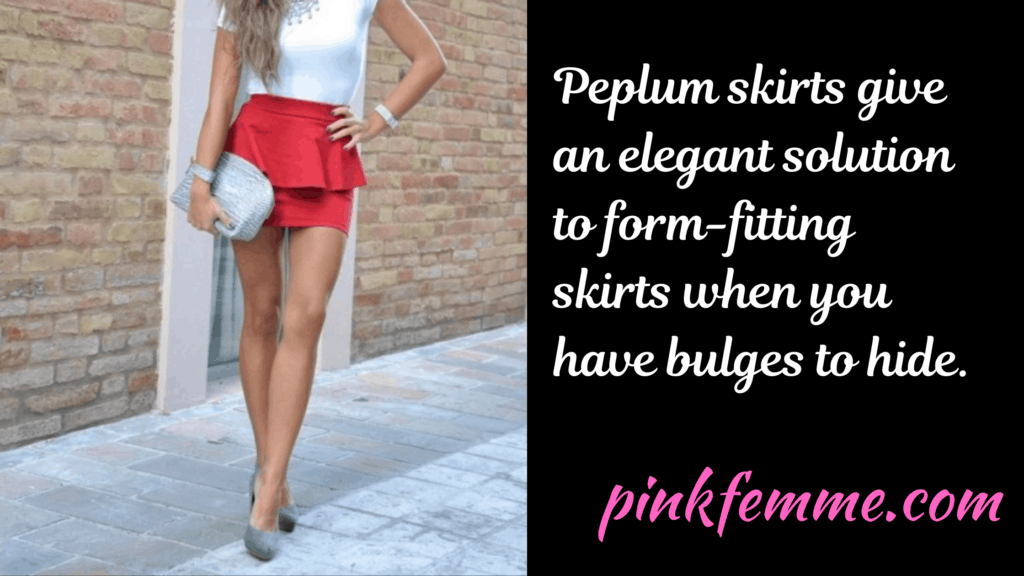
If you like the feel of a form-fitting skirt but maybe have bulges that you’d prefer to be kept hidden or want to balance out wide shoulders with a flare at the hipline then a peplum skirt will be your ideal solution.
A peplum is a strip of fabric that is added to a garment that looks loosely gathered and gives the garment flounce. It adds movement to a garment that would otherwise be form-fitting.
Let’s look more closely at the skirt designed to hide any less than flattering bulges that you may have.
What Are The Significant Features Of Peplum Skirts?
First, let’s look at what a peplum is. A peplum is basically a strip of fabric that can be added to a garment and looks loosely gathered in appearance once added and gives the garment a flounce. So, think of a pencil skirt with a large ruffle added that goes all the way around the top of the skirt and goes down to the hip area to get an idea of what a peplum skirt looks like.
Peplum skirts usually sit around the knee or above and whilst the main part of a peplum skirt may not offer much movement when you walk, the peplum itself may move a little. There are different types of peplum skirts available with all sorts of peplums added to them from asymmetrical to multi-layer to two-tone. Peplums can also be added to dresses, tops, and jackets and they can be very short or rather long!
What Are The Origins Of Peplum Skirts?
The word “peplum” is the Greek word for tunic. And if we were to go back to 500 B.C. we would find Greek women wearing long, flowing garments called peplos. A peplos was an Ancient Greek dress that featured a large overfold starting at the shoulders, where it was usually pinned, and ending around the waist area.
Fast forward to the 19th century and peplums could be found on women’s jackets which were worn over hoop skirts. Then in 1947, Christian Dior launched his first collection known as the “New Look”. In the collection, there were jackets known as “Bar” jackets that featured cinched waists and flared out over the hip. And it is these jackets that Dior paired with full skirts that most closely resemble the peplum skirt as we know it today.
What Figure/Body Shape Is Best Suited To Peplum Skirts?
It has to be the hourglass body shape that is best suited to this skirt simply because it shows off the waist and accentuates the curves! But the peplum skirt can also work well for rectangle and inverted triangle body shapes as it can improve the waist-to-hip ratio and add balance to the body.
Pear shapes may want to avoid this skirt because it can make the hip area look bigger. And whilst apple shapes may be drawn to this skirt because it can cover the tummy area quite well, it’s actually a skirt that does nothing for the waistline so it’s one to stay away from.
Which Kinds Of Tops Can You Pair With Peplum Skirts?
Off-the-shoulder tops; tops with a sweetheart neckline, crop tops, camisoles, and slim-fit blouses look great with peplum skirts. As do t-shirts, whether they are long or short-sleeved.
As long as the top is close-fitting then you are most likely onto a fab look. This is because peplum skirts draw attention to the waist and hips, so you don’t want too much going on with your top half otherwise it will be competing with your bottom half for attention!
What Shoes Work Best With Peplum Skirts?
Pointed stilettos, strappy high heel sandals, open-toe heels with an ankle strap, and peep-toe heels can all look amazing with a peplum skirt. And when it gets a bit chilly outside, wear a pair of stylish, heeled ankle boots to add some edge to your outfit!
If you’re not keen on heels then pointed ballet flats will look great too. And you can create a cute, casual look by pairing a peplum skirt with a t-shirt and on-trend trainers.
Why not expand your style and fashion knowledge even further by reading another style/fashion article here on Pink Femme. You can find them either via the menu at the top of the page or by clicking this link that will take you to the list of all my style and fashion articles.
